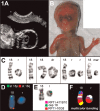Three unusual but cytogenetically similar cases with up to five different cell lines involving structural and numerical abnormalities of chromosome 18
- PMID: 17595336
- PMCID: PMC3957532
- DOI: 10.1369/jhc.7A7244.2007
Three unusual but cytogenetically similar cases with up to five different cell lines involving structural and numerical abnormalities of chromosome 18
Abstract
We report two prenatal and two postnatal diagnosed cases (the latter monozygotic twins) with ring chromosomes after GTG banding. All four, de novo r(18), cases turned out to be more complex after application of high-resolution molecular cytogenetics techniques such as use of fluorescence in situ hybridization, centromeric probes, multicolor banding, and locus-specific probes for chromosome 18. All four cases are mosaics involving chromosome 18 in up to five different cell lines, including 46,r(18); 46,dr(18); 47,r(18)x2; 46,mar(18); and 45,-18. Mosaicism sharing both numerical and structural anomalies is rare, but rings often appear as mosaics due to their mitotic instability. Overall, patients with ring chromosome 18 usually share clinical features of 18q- syndrome and, less frequently, those of 18p- syndrome. High-resolution molecular cytogenetics techniques were useful in the characterization of cases with dynamic mosaicism and in establishing the relationship between loss or gain of chromosomal material and the phenotype.
Figures


Similar articles
-
Prenatal diagnosis and clinical features of an individual with tetrasomy 18p and trisomy 18q mosaicism.J Perinatol. 1998 Sep-Oct;18(5):395-8. J Perinatol. 1998. PMID: 9766419
-
Clinical and molecular-cytogenetic studies in seven patients with ring chromosome 18.Am J Med Genet. 2001 Jul 1;101(3):226-39. doi: 10.1002/1096-8628(20010701)101:3<226::aid-ajmg1349>3.0.co;2-#. Am J Med Genet. 2001. PMID: 11424138
-
[Fluorescence in situ hybridization in 6 patients with alterations of chromosome 18 and in 7 with marker chromosomes].Rev Invest Clin. 1996 Jan-Feb;48(1):27-33. Rev Invest Clin. 1996. PMID: 8815483 Spanish.
-
Prenatal diagnosis of a small supernumerary, XIST-negative, mosaic ring X chromosome identified by fluorescence in situ hybridization in an abnormal male fetus.Prenat Diagn. 2003 Feb;23(2):143-5. doi: 10.1002/pd.553. Prenat Diagn. 2003. PMID: 12575022 Review.
-
Prenatal diagnosis of partial trisomy 1q using fluorescent in situ hybridization.Am J Med Genet. 1994 Mar 1;50(1):21-7. doi: 10.1002/ajmg.1320500105. Am J Med Genet. 1994. PMID: 8160748 Review.
Cited by
-
Human interphase chromosomes: a review of available molecular cytogenetic technologies.Mol Cytogenet. 2010 Jan 11;3:1. doi: 10.1186/1755-8166-3-1. Mol Cytogenet. 2010. PMID: 20180947 Free PMC article.
-
DNA probe pooling for rapid delineation of chromosomal breakpoints.J Histochem Cytochem. 2009 Jun;57(6):587-97. doi: 10.1369/jhc.2009.953638. Epub 2009 Feb 16. J Histochem Cytochem. 2009. PMID: 19223294 Free PMC article.
-
Human Ring Chromosomes - New Insights for their Clinical Significance.Balkan J Med Genet. 2013 Jun;16(1):13-20. doi: 10.2478/bjmg-2013-0013. Balkan J Med Genet. 2013. PMID: 24265580 Free PMC article.
-
A Case of Ring Chromosome 18 with Single Umbilical Artery Detected During Prenatal Period.Mol Syndromol. 2020 Nov;11(4):217-222. doi: 10.1159/000509646. Epub 2020 Sep 10. Mol Syndromol. 2020. PMID: 33224015 Free PMC article.
-
Mosaic chromosome 18 anomaly delineated in a child with dysmorphism using a three-pronged cytogenetic techniques approach: a case report.BMC Med Genomics. 2020 Sep 24;13(1):141. doi: 10.1186/s12920-020-00796-9. BMC Med Genomics. 2020. PMID: 32972420 Free PMC article.
References
-
- Baumer A, Uzielli MLG, Guarducci S, Lapi E, Rothlisberger B, Shinzel A. (2002) Meiotic origin of two ring chromosomes 18 in a girl with developmental delay. Am J Med Genet 113: 101–104 - PubMed
-
- Bird LM, Pretorius DH, Mendonza AE, Jones MC. (1997) Anencephaly with holoprosencephalic facies due to ring chromosome 18. Clin Dysmorphol 6: 351–358 - PubMed
-
- Cody JD, Ghidoni PD, DuPont BR, Hale DE, Hilsenbeck SG, Stratton RF, Hoffman DS, et al. (1999) Congenital anomalies and anthromometry of 42 individuals with deletions of chromosome 18q. Am J Med Genet 85: 455–462 - PubMed
-
- Cohen MM. (1989) Perspectives on holoprosencephaly: Part I. Epidemiology, genetics, and syndromology. Teratology 40: 211–235 - PubMed
Publication types
MeSH terms
LinkOut - more resources
Full Text Sources
Medical

